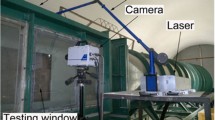Abstract
Film cooling downstream of a model turbine blade trailing edge has been studied experimentally. High resolution particle image velocimetry was used to obtain spatially resolved mean velocity and turbulence measurements in the immediate vicinity of the trailing edge breakout. The mean velocity measurements imply the presence of a pair of counter-rotating longitudinal vortices shed from the sides of the breakout lands. The turbulent shear stress measurements above the breakout are significantly intensified as blowing ratio is increased. These results suggest that there is a strong mixing between the film cooling slot jets and the mainstream flow which degrades the film cooling effectiveness.


















Similar content being viewed by others
Abbreviations
- A exit :
-
Area of the exit slot
- c :
-
Chord length of the NACA0012
- d :
-
Length between the center of the breakout slot and the land
- M :
-
Blowing ratio
- \({\mathop Q\limits^\bullet}_{\rm fc}\) :
-
Film cooling flow rate
- R uw :
-
Reynolds stress correlation coefficient
- T aw :
-
Adiabatic wall temperature
- T c :
-
Coolant temperature
- T ∞ :
-
Mainstream temperature
- u,v,w :
-
Local mean velocities in x, y, z directions, respectively
- u ref :
-
Bulk average velocity
- \(\overline{{u^{\prime}u^{\prime}}}\) :
-
Streamwise Reynolds normal stress component
- \(\overline{{u^{\prime}w^{\prime}}}\) :
-
Reynolds shear stress component
- \(\overline{{w^{\prime}w^{\prime}}}\) :
-
Vertical Reynolds normal stress component
- x,y,z :
-
Fixed Cartesian system
- η:
-
Adiabatic film cooling effectiveness
- ρcoolant :
-
Density of the coolant fluid
- ρmainstream :
-
Density of the mainstream fluid
References
Cunha FJ, Chyu MK (2006) Trailing-edge cooling for gas turbines. J Propuls Power 22:286–300
Goldstein RJ (1971) Film cooling. Adv Heat Transf 7:321–379
Han D (2001) Study of turbulent nonpremixed jet flames using simultaneous measurements of velocity and CH distribution. PhD Thesis, Stanford University
Holloway DS, Leylek JH, Buck FA (2002a) Pressure-side bleed film cooling: part 1, steady framework for experimental and computational results. ASME Turbo Expo 2002 GT2002–30471
Holloway DS, Leylek JH, Buck FA (2002b) Pressure-side bleed film cooling: part 2, unsteady framework for experimental and computational results. ASME Turbo Expo 2002 GT2002-30472
Kacker SC, Whitelaw JH (1968) The effect of slot height and slot turbulence intensity on the effectiveness of the uniform density, two-dimensional wall jet. ASME J Heat Transf 90:469–475
Kacker SC, Whitelaw JH (1969) An experimental investigation of the influence of slot lip thickness on the impervious-wall effectiveness of the uniform-density, two dimensional wall jet. Int J Heat Mass Transf 12:1196–1201
Kim YW, Coon C, Moon, HK (2005) Film-cooling characteristics of pressure-side discharge slots in an accelerating mainstream flow. ASME Turbo Expo 2005 GT2005–69061
Launder BE, Rodi W (1983) The turbulent wall jet—measurements and modeling. Annu Rev Fluid Mech 15:429–459
Martini P, Schulz A (2004) Experimental and numerical investigation of trailing edge film cooling by circular coolant wall jets ejected from a slot with internal rib arrays. J Turbomach 126:229–236
Martini P, Schulz A, Bauer, HJ (2005) Film cooling effectiveness and heat transfer on the trailing edge cutback of gas turbine airfoils with various internal cooling designs. ASME Turbo Expo 2005 GT2005–68083
Medic G, Durbin PA (2005) Unsteady effects on trailing edge cooling. ASME J Fluids Eng 127:388–392
Mehlman BP (1990) Experimental slot film cooling effectiveness measurements for varying injection angles in accelerating and non-accelerating flows. MS Thesis, Massachusetts Institute of Technology, Boston
Metzger DE, Carper HJ, Swank LR (1968) Heat transfer with film cooling near nontangential injection slots. J Eng Power 90:157–163
Nicoll WB, Whitelaw JH (1966) The effectiveness of the uniform density, two dimensional wall jet. Int J Heat Mass Transf 10:623–639
Pai BR, Whitelaw JH (1970) The prediction of wall temperature in the presence of film cooling. Int J Heat Mass Transf 14:409–426
Papell SS (1960) Effect on gaseous film cooling injection through angled slots and normal holes. NASA TN-D-299
Paxson DE, Mayle RE (1989) The influence of a mainstream thermal boundary layer on film effectiveness. J Turbomach 111:491–496
Rastogi AK, Whitelaw JH (1972a) The effectiveness of three-dimensional film-cooling slots–I. Measurements. Int J Heat Mass Transf 16:1665–1672
Rastogi AK, Whitelaw JH (1972b) The effectiveness of three-dimensional film-cooling slots—II. Predictions. Int J Heat Mass Transf 16:1673–1681
Samuel AE (1965) Film cooling of an adiabatic flat plate in zero pressure gradient in the presence of a hot mainstream and cold tangential secondary injection. J Heat Transf, TRANS ASME 87:409–418
Sivasegaram S, Whitelaw JH (1969) Film cooling slots: the importance of lip thickness and injection angle. J Mech Eng Sci 11:22–27
Taslim ME, Spring SD, Mehlman BP (1992) Experimental investigation of film cooling effectiveness for slots of various exit geometries. J Thermophys Heat Transf 6:302–307
Uzol O, Camci, C (2001a) Aerodynamic loss characteristics of a turbine blade with trailing edge coolant ejection: part 1—effect of cutback length, spanwise rib spacing, free-stream Reynolds number, and chordwise rib length on discharge coefficients. J Turbomach 123:238–248
Uzol O, Camci C (2001b) Aerodynamic loss characteristics of a turbine blade with trailing edge coolant ejection: part 2—external aerodynamics, total pressure losses, and predictions. J Turbomach 123:249–257
Acknowledgments
The present study was funded by the AFOSR under Grant# FA9550-05-1-0183. The authors would like to thank Jongwook Joo for his assistance with the design of the flow geometry. The airfoil model was fabricated by Mr. Frank Medina at the University of Texas El Paso.
Author information
Authors and Affiliations
Corresponding author
Rights and permissions
About this article
Cite this article
Chen, Y., Matalanis, C.G. & Eaton, J.K. High resolution PIV measurements around a model turbine blade trailing edge film-cooling breakout. Exp Fluids 44, 199–209 (2008). https://doi.org/10.1007/s00348-007-0391-2
Received:
Revised:
Accepted:
Published:
Issue Date:
DOI: https://doi.org/10.1007/s00348-007-0391-2




